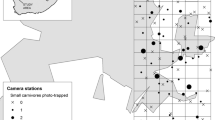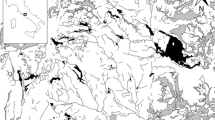Abstract
This study tests the hypothesis that competition occurs in a community of three species of small mammals (Antechinus stuartii and A. swainsonii, Marsupialia; Rattus fuscipes, Rodentia) in south-eastern Australia. The hypothesis was tested by using a simple model of competition that is based on two premises: I. competition results in a negative numerical or a negative spatial association between species, and II. competition is more intense where the densities of the competing species are relatively high. The model combines both premises and predicts that measures of association between competing species will be more negative where the species exist at high population densities than derived from the model and applied to data gathered in two study areas with contrasting mean animal densities. There was no evidence of numerical association among the species (three tests), but evidence of negative spatial association (three tests our of four). These latter findings were consistent with the predictions of the model. All species preferred the same broad kinds of habitat (macrohabitat), but they segregated into smaller, finer grained patches (microhabitat) when their numbers were relatively high. Such segregation was more evident between the two species of marsupials than between either species of marsupial and the eutherian rat. These findings suggested that competition occurs by interference, and reinforce the idea that an understanding of the behaviour of individuals is important to understanding competition between species.
Similar content being viewed by others
References
Abramsky Z, Dyer MI, Harrison PD (1979) Competition among small mammals in experimentally perturbed areas of the shortgrass prairie. Ecology 60:530–536
Barnett JL, How RA, Humphries WF (1978) The use of habitat components by small mammals in eastern Australia. Aust J Ecol 3:277–285
Blaustein AR (1980) Behavioral aspects of competition in a three-species rodent guild of coastal southern California. Behav Ecol Sociobiol 6:247–255
Braithwaite RW (1973) An ecological study of Antechinus stuartii (Marsupialia: Dasyuridae). M. Sc. thesis, University of Queensland, Brisbane
Braithwaite RW, Cockburn A, Lee AK (1978) Resource partitioning by small mammals in lowland heath communities of south-eastern Australia. Aust J Ecol 3:423–445
Brown JH (1978) Effects of mammalian competitors on the ecology and evolution of communities. In: Snyder DP (ed) Populations of small mammals under natural conditions, vol 5. Special Publication Series, Pymatuning Laboratory of Ecology, University of Pittsburg, pp 52–57
Cohen MN, Malpass RS, Klein HG (eds) (1980) Biosocial mechanisms of population regulation. Yale University Press, New Haven
Cole LC (1957) The measurement of partial interspecific association. Ecology 38:226–233
Connell JH (1975) Some mechanisms producing structure in natural communities: a model and evidence from field experiments. In: Cody ML, Diamond JM (eds) Ecology and evolution of communities. Harvard University Press, Cambridge, Mass., pp 460–490
Cormack RM (1979) Spatial aspects of competition between individuals. In: Cormack RM, Ord JK (eds) Spatial and temporal analysis in ecology. International Cooperative Publ House, Fairland, Maryland, pp 151–212
Daly M, Wilson MI, Behrends P (1980) Factors affecting rodents' responses to odours of strangers encountered in the field: Experiment with odour-baited traps. Behav Ecol Sociobiol 6:323–329
Diamond JM (1978) Niche shifts and the rediscovery of interspecific competition. Am Sci 66:322–331
Dickman CR (1980) Niche shift and interaction among Antechinus. Bull Aust Mammal Soc 6:32
Dickman CR (1983) Competition and coexistence among the small marsupials of Australia and New Guinea. Acta Zool Fenn (in press)
Fager EW (1957) Determination and analysis of recurrent groups. Ecology 38:586–595
Fenton MB, Fleming TH (1976) Ecological interactions between bats and nocturnal birds. Biotropica 8:104–110
Fox BJ (1982a) Ecological separation and coexistence of Sminthopsis murina and Antechinus stuartii (Dasyuridae, Marsupialia): A regeneration niche? In: Archer M (ed) Carnivorous marsupials. Roy Zool Soc N.S.W., Sydney, pp 187–197
Fox BJ (1982b) A review of dasyurid ecology and speculation on the role of limiting similarity in community organisation. In: Archer M (ed) Carnivorous marsupials. Roy Zool Soc N.S.W., Sydney, pp 97–116
Glass GE, Slade NA (1980) The effect of Sigmodon hispidus on spatial and temporal activity of Microtus ochrogaster: evidence for competition. Am Midl Nat 86:1–12
Goertz GW (1971) An ecological study of Microtus pinetorum in Oklahoma. Am Midl Nat 86:1–12
Grant PR (1971) Experimental studies of competitive interaction in a 2-species system. III. Microtus and Peromyscus species in enclosures. J Anim Ecol 40:323–350
Grant PR (1972) Interspecific competition among rodents. Ann Rev Ecol Syst 3:79–106
Grant PR (1978) Competition between species of small mammals. In: Snyder DP (ed) Populations of small mammals under natural conditions, vol 5. Special Publication Series, Pymatuning Laboratory of Ecology, University of Pittsburg, pp 38–51
Hall S (1980a) The diets of two coexisting species of Antechinus (Dasyuridae, Marsupialia). Aust Wildl Res 7:365–378
Hall S (1980b) Diel activity of three small mammals coexisting in forest in southern Victoria. Aust Mammal 3:67–80
Hall S, Lee AK (1982) Habitat use by two species of Antechinus and Rattus fuscipes in tall open forest in southern Victoria In: Archer M (ed) Carnivorous marsupials. Roy Zool Soc N.S.W., Sydney, pp 209–220
Hawes ML (1976) Odor as a possible isolating mechanism in sympatric species of shrews (Sorex vagrans and Sorex obscurus). J Mammal 57:404–406
Hayne DW (1978) Experimental designs and statistical analysis in small mammal population studies. In: Snyder DP (ed) Populations of small mammals under natural conditions, vol 5. Special Publication Series, Pymatuning Laboratory of Ecology, University of Pittsburg, pp 3–10
Holbrook SJ (1978) Habitat relationships and coexistence of 4 sympatric species of Peromyscus in Northeastern New Mexico. J Mammal 59:18–26
Hurlbert SH (1969) A coefficient of interspecific association. Ecology 50:1–9
Krebs CJ (1966) Demographic changes in fluctuating populations of Microtus californicus. Ecol Monogr 36:239–273
Krebs CJ (1972) Ecology. Harper and Row, New York
Lomnicki A (1978) Individual differences between animals and the natural regulation of their numbers. J Anim Ecol 47:461–475
MacArthur RH (1972) Geographical ecology. Harper and Row, New York
M'Closkey RT (1981) Microhabitat use in coexisting desert rodents — the role of population density. Oecologia (Berl) 50:310–315
M'Closkey RT, Fieldwick B (1975) Ecological separation of sympatric rodents (Peromyscus and Microtus). J Mammal 56:119–129
May RM (ed) (1976) Theoretical ecology: principles and applications. Blackwell Scientific Publications, Oxford
Mihok S (1979) Behavioral structure and demography of subarctic Clethrionomys gapperi and Peromyscus maniculatus. Can J Zool 57:1520–1535
Miller RS (1967) Pattern and process in competition. In: Cragg JB (ed) Advances in Ecological Research No. 4. Academic Press, London New York, pp 1–67
Myers JH (1974) Genetic and social structure of feral house mouse populations on Grizzly Island, California. Ecology 55:747–759
Parker RE (1973) Introductory Statistics for Biology. Studies in Biology No. 43, Edward Arnold, London
Persson O (1971) The robustness of estimating density by distance measurements. In: Patil GP, Pielon EC, Waters WE (eds) Statistical Ecology, vol 2. Pennsylvania State University Press, University Park, pp 175–190
Pianka ER (1978) Evolutionary ecology. Harper and Row, New York
Press A (1976) Some aspects of the ecology and habitat utilisation of four species of native small animals. B. Sc. (Hons.) Thesis, Sydney University, Sydney
Sale PF (1974) Overlap in resource use, and interspecific competition. Oecologia 17:245–256
Schoener TW (1974a) Resource partitioning in ecological communities. Science 185:27–39
Schoener TW (1974b) Competition and the form of habitat shift. Theor Pop Biol 6:265–307
Schroder GD, Rosenzweig ML (1975) Perturbation analysis of competition and overlap in habitat utilisation between Dipodomys ordii and Dipodomys merriami. Oecologia 19:9–28
Simpson GG, Roe A, Lewontin RC (1960) Quantitative Zoology. Harcourt, Brace & Co., New York
Slade NA (1976) Analysis of social structure from multiple capture data. J Mammal 57:790–795
Taylor RAJ, Taylor LR (1979) A behavioural model for the evolution of spatial dynamics. In: Anderson RM, Turner BD, Taylor LR (eds) Population Dynamics. Blackwells, Oxford, pp 1–27
Terman MR (1974) Behavioral interactions between Microtus and Sigmodon: a model for competitive exclusion. J Mammal 55:705–719
Terman MR (1978) Population dynamics of Microtus and Sigmodon in central Kansas. Trans Kansas Acad Sci 81:337–351
Wiens JA (1977) On competition and variable environments. Am Sci 65:590–597
Woodside DP (1983) The role of social behaviour and spacing in populations of the bush rat, Rattus fuscipes. Ph. D. thesis, Department of Zoology, Australian National University, Canberra
Author information
Authors and Affiliations
Rights and permissions
About this article
Cite this article
Dickman, C.R., Woodside, D.P. A test of a competition model with reference to three species of small mammals in south-eastern Australia. Oecologia 60, 127–134 (1983). https://doi.org/10.1007/BF00379332
Received:
Issue Date:
DOI: https://doi.org/10.1007/BF00379332




